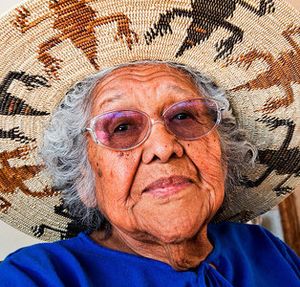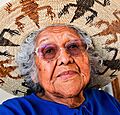Katherine Siva Saubel facts for kids
Quick facts for kids
Katherine Siva Saubel
|
|
|---|---|
 |
|
| Born |
Katherine Siva
March 7, 1920 |
| Died | November 1, 2011 (aged 91) Morongo Reservation, California, U.S.
|
| Resting place | Saint Marys Catholic Cemetery Morongo Reservation |
| Alma mater | La Sierra University |
| Occupation |
|
| Known for | Preservation of the Cahuilla language, culture and history |
| Spouse(s) |
Mariano Saubel
(m. 1940; died 1985) |
| Children | 1 |
Katherine Siva Saubel (born March 7, 1920, died November 1, 2011) was a Native American leader. She worked hard to save her Cahuilla people's history, culture, and language. Many people in California and around the world respected her.
She earned a special degree (an honorary PhD) from La Sierra University. She also received the Chancellor's Medal, a top award from the University of California, Riverside. Saubel was a member of the Los Coyotes Band of Cahuilla and Cupeno Indians. She even served as their tribal chairperson.
Contents
Early Life and Learning
Katherine Siva Saubel was the eighth of eleven children. She grew up speaking only the Cahuilla language at home. She did not learn English until she started school at age seven.
Her mother, Melana Sawaxell, spoke only Cahuilla. Her father, Juan C. Siva, learned four languages. These were Cahuilla, Spanish, Latin, and English.
Saving the Cahuilla Language
When Katherine was in high school, she noticed something worrying. Her friends would answer her in English when she spoke Cahuilla. She became worried that her people were losing their language.
She started writing down the names of plants and herbs. She also wrote how her mother used them. This information came from their gathering trips.
This notebook later became a book called Temalpakh: (From the Earth) Cahuilla Indian knowledge and usage of plants. Saubel worked on it for ten years with Dr. Lowell John Bean. It was published in 1972. The book showed how much Saubel knew about Cahuilla culture. It also showed her knowledge of ethnobotany. This is the study of how people use plants. Saubel was an expert on how the Cahuilla used plants like mesquite and datura.
Important Work
In 1962, Saubel helped Professor William O. Bright. He was a professor of American linguistics. She helped him study the Cahuilla language. She also helped him prepare several books.
She taught classes with Professor Bright and Professor Pamela Munro. She also wrote a book with Munro called Chem’i’vullu: Let’s Speak Cahuilla. It was published in 1981 by UCLA.
Writing Down Cahuilla
Starting in 1964, Saubel worked with Professor Hansjakob Seiler. He was a linguist from the University of Cologne, Germany. They worked to create a written form of the Cahuilla language. Before this, it only existed as a spoken language.
Their work led to a Cahuilla grammar book and a dictionary. Saubel also published her own dictionary, I’sniyatam Designs, a Cahuilla Word Book. Her work includes many true stories and English translations of Cahuilla folklore.
Malki Museum
In 1958, Jane Penn had an idea. She wanted to open a museum on the Malki Cahuilla reservation. This reservation is now called the Morongo Reservation. She wanted to show her collection of Cahuilla items. She also wanted to create a place to save the culture.
With help from Lowell John Bean and their husbands, they started the Malki Museum. It became a non-profit organization. Saubel was asked to be the president of the museum. Jane Penn became its director.
The Malki Museum opened in February 1965. It was the first non-profit museum on an Indian reservation. It still shows items from ancient times to today. The museum also has a publishing part called Malki Press. It publishes books about Native Americans in Southern California.
Recognitions and Awards
Katherine Saubel's research has been published around the world. Her knowledge of Cahuilla culture and plants was so important. Because of this, US state and federal leaders asked for her advice.
California governors have honored her. She was also appointed to many groups and agencies.
- She served on the Riverside County Historical Commission for many years. They named her County Historian of the Year in 1986.
- In 1987, the California State Indian Museum named her "Elder of the Year."
- Governor Jerry Brown appointed her to the California Native American Heritage Commission in 1982. In this role, she helped protect sacred sites and Native American remains.
Saubel shared her knowledge of Native American culture and history. She spoke to the California legislature and the United States Congress. She also taught Cahuilla history and culture. She taught at UC Riverside, UCLA, and universities in Germany and Japan.
In 2004, her book Isill Heqwas Waxizh: A Dried Coyote's Tail was published. She wrote it with Dr. Eric Elliot.
Awards and Honors
Saubel received many important awards, including:
- First Recipient of the Smithsonian Institution National Museum of the American Indian Art and Culture Award (1994)
- California State Indian Museum – Elder of the Year (1987)
- The Desert Protective Council Award
- YWCA Woman of Achievement Award (Riverside County, California)
- Bridge To Peace Award
- Latino and Native American Hall of Fame (Riverside, California)
- First Recipient of the California Indian Heritage Preservation Award (2000)
- Indian of the Year – California Indian Conference (2000)
- First Native American woman to join the National Women's Hall of Fame in Seneca Falls, New York (1993)
Images for kids


